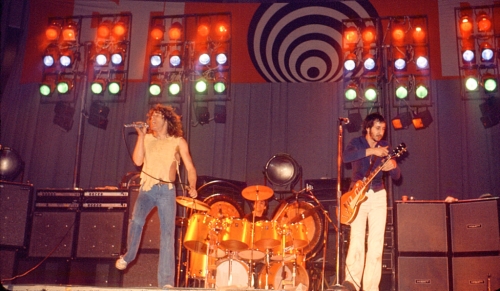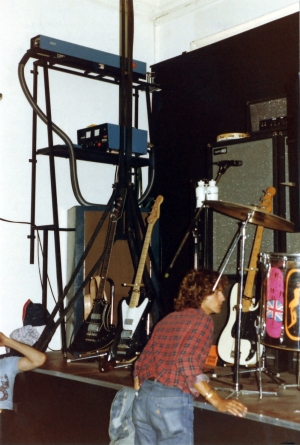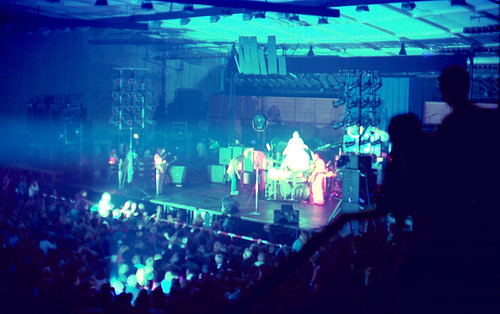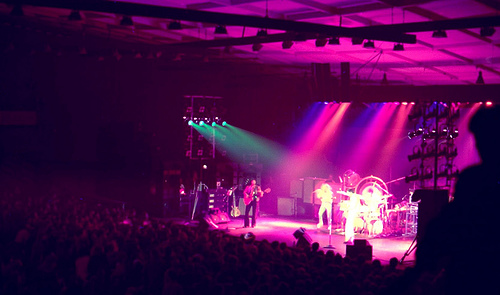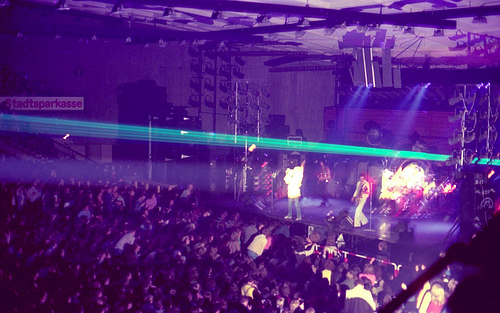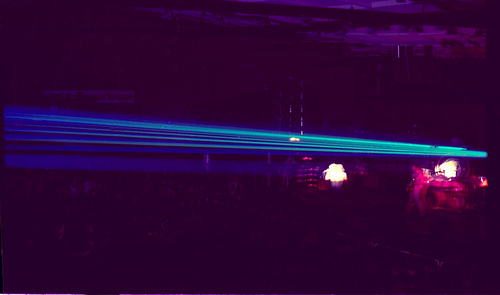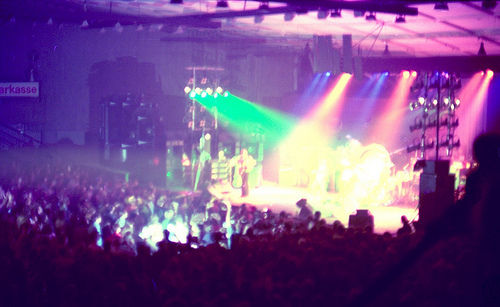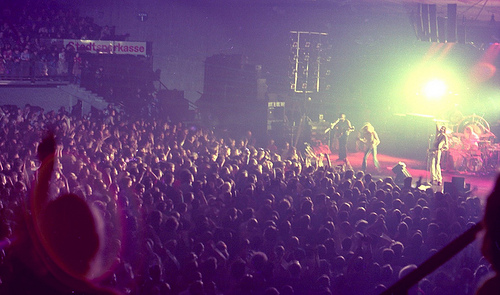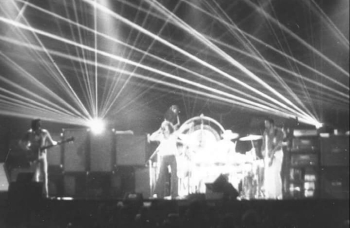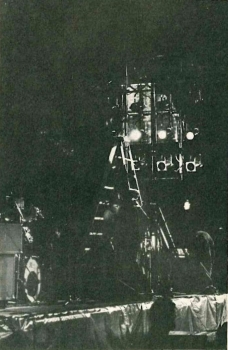The Who’s PA: Stage Lighting
The Who were pioneers in stage lighting and lasers. Special thanks to Roger Searle for providing the following timeline information about The Who’s lighting, without whom this information would not be available. Roger was a member of The Who’s roadcrew from 1967–1986.
Until 1970
Roger Searle:
Pre-1970 we used whatever we could find that worked in whichever venue we were at. There was no equipment to hire as such!!
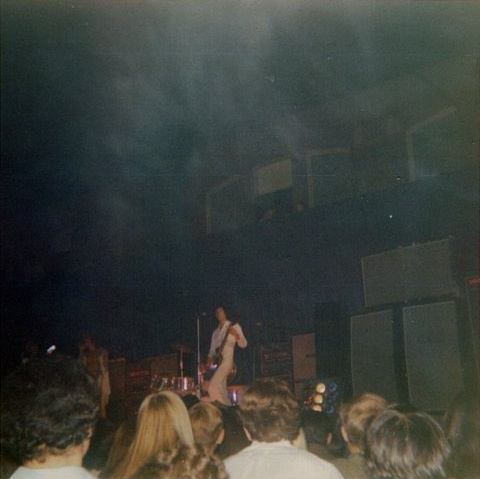
10 Oct., 1969, Commonwealth Armory, Boston, with nine-gel light next to Marshall 8×10 cabinets.
Beginning 1970

16 Feb. 1970 – Hull City Hall.
Roger Searle:
The original Electrosonic desk was purchased in 1970. It always went on stage right as we could not run AC power into the audience. At that time we used to hire lamps from a theatre lighting company in London but they could not supply a suitable portable desk.
We were put in touch with Electrosonic and basically told them to produce a desk that we could “tour.” The desk they produced was a three-preset desk with an electronic cross-fade (i.e., lamp on/lamp off) sequence as well as a mechanical “chase” unit. The desk ran on either three-phase input power of 60-amps/240v per phase or 100amp single phase input.
The change was achieved by a miniature “buzz bar” section on the main input section. The outputs were 18 × 15-amp theatre-style sockets (two per control fader). If memory serves there was a selector switch on each fader which decided preset master A, B or C.
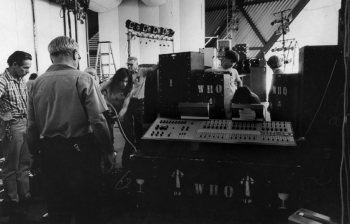
Click to view larger version. 16 Aug. 1971, Edwardsville, Illinois, the Electrosonic control board in the backline at stage right.
In the early days I used to power this via a 100amp 3ph changeover switch. At a certain part of the show we would throw the switch diverting power from the desk to three 10,000-watt film lamps arranged across the back of the stage facing the audience. Most venues at this time did not have enough spare power for us to use everything at once so it was one or the other. A bit basic but it worked.
We took this desk to the USA in 1971 and on the same tour purchased a load of second-hand Lekos in New York which formed the basis of The Who’s lightshow for some years.
From 1971 Billboard interview with Pete Rudge, the Who’s tour manager:
Home on the road for the equipment is a specially designed 40-foot-long truck with a long wheelbase.
The Who travel big: 10 extra people around to make sure they stage and sound perfect. Four come from England including Pridden, who is the only road manager who has his own chauffer (“Superstar?” says Rudge) and doesn’t travel with the equipment. And there is John Wolfe, who like Pridden, has been with the Who for six years. Pridden and Wolfe are Townshend discoveries and they also work with the group when they are in the recording studios.
It is essential they arrive early. The advance party go into the city the night before the actual concert and get to the auditorium at 8 a.m. This is is when the truck is driven over and the road team—the last tour Rudge hired four extra men because of the equipment volume—start work. Rudge maintains it takes 12 hours to get the Who set up properly because the Who travel with their own lighting system. “We carry around 50 lights and each one has to be put up individually—rather like traveling with a circus,” says Rudge.
Notes
-
15 June 1970 – Berkeley Community Theater, Berkeley, California
According to Pete Rudge, Bill Graham suggests using film spotlights at backstage to shine into the audience.
Eyewitness The Who:
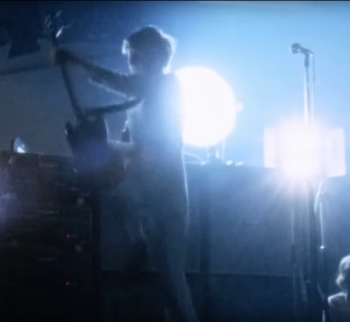
Still from third Isle of Wight Festival, 29–30 August 1970, with large film lamp (on) behind Pete’s amps.
Peter Rudge: We played in the Berkeley Community Theater with the Jefferson Airplane sitting in the fourth row. It was Bill Graham’s idea to put these big spotlights behind The Who and shine them into the house. We paid for it but it was Bill’s idea and The Who took it with them when they left.
Pete: Bill did that thing with the Super Troopers for Tommy when we played for him in the Berkeley Community Theater. Fucking great-sounding hall. … suddenly the curtain rose and there was 4,000 watts of light on the band. Of course, we picked up that technique and we’ve used it ever since.
-
25 July, 1970 – Civic Hall, Dunstable
Concert File: first UK date of of new lighting system:
The bright lamps at the back of the stage were used on the audience during ‘See Me, Feel Me’ for the first time in the UK at this show. The Who had begun to be billed as “the most exciting stage act in the world” around this time.
-
29–30 August 1970 – 3rd Isle of Wight festival
Anyway Anyhow Anywhere:
“I had these 25,000 watt spotlights which operated from the back of the stage,” said [Wiggy] Wolff. “They had their own generator and during ‘See Me, Feel Me,’ we turned them on full into the crowd. All the moths in the Isle of Wight flew into the beams!”
Photo gallery
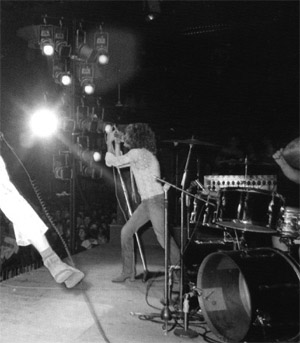
29 Oct. 1970, rear of Electrosonic control board visible at stage right.
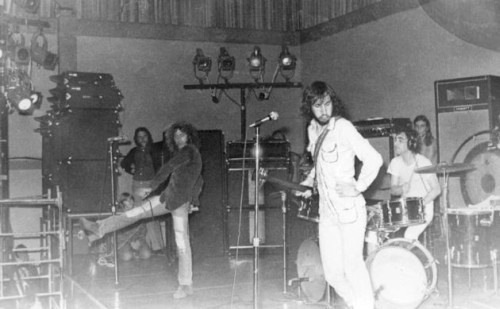
9 Oct. 1971.
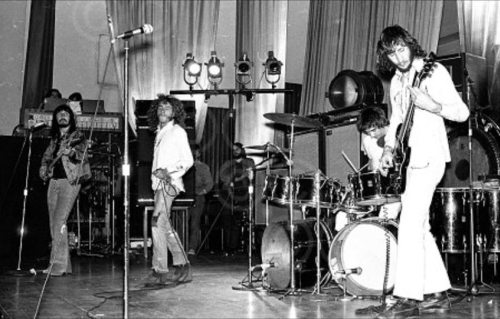
Click to view larger version. 19 Oct. 1971, Guild Hall, Southampton, rear of Electrosonic control board visible at stage right.
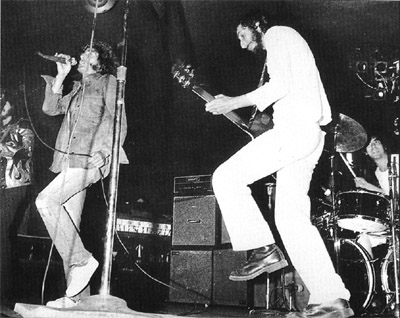
21 Aug. 1972, KB-Hallen, Denmark, Electrosonic control board set up at rear of stage right.
Film lamps
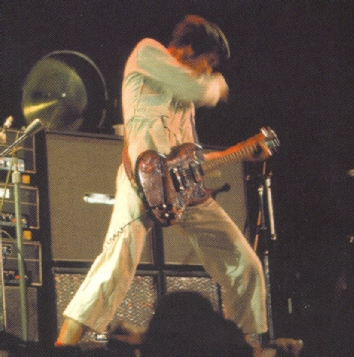
Close-up of large film lamp (off) behind Pete’s amps, at the third Isle of Wight Festival, 29–30 August 1970.
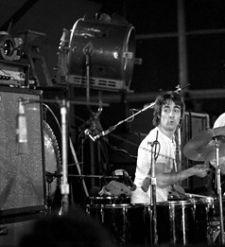
18 Sept. 1971, side detail of large film lamp (off) behind Keith’s drumkit.
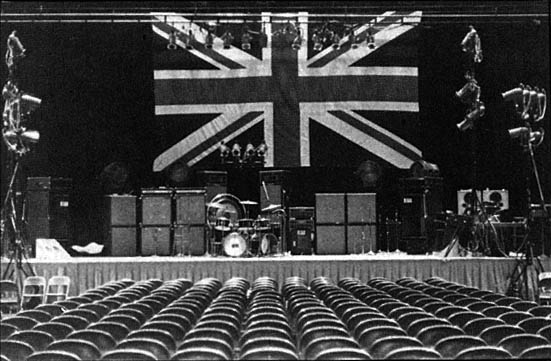
Late 1971 stage setup, showing lighting rig as well as four large film lamps arranged across the rear of the stage.
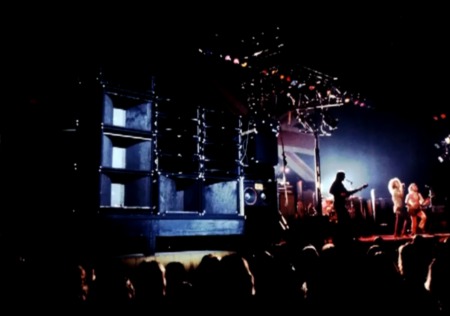
Ca. December 1971, view of stage lighting.
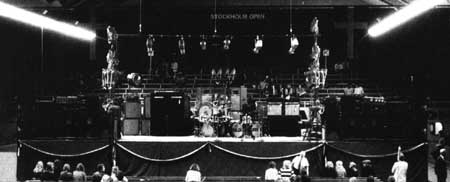
Mid-1972 stage setup, 23 Aug., 1972, Stockholm, Sweden. (Note: opening act’s gear is set up on stage in front of The Who’s gear.)
1973–1974
Roger Searle:
I think the desk shown below was manufactured around 1974 when we started to use Bill McManus and his lighting company. I am not sure that this desk ever went back to the UK.
1974 – Electronics Diversified Dimmer light control board
A dimmer light control board reportedly used by The Who and available for auction on eBay in October 2005. Photos and info courtesy the iSold It Store located at: 695 Kidder Street (Store 13) Wilkes-Barre, Pa., 18702, USA. Tel.: (570) 821-5711.
Auction description:
Dimmer Light control board, which was built by Electronics Diversified in conjunction with McManus Entertainment exclusively for The Who. This was first used on tour in support of the Quadrophenia album. This dimmer board controlled every aspect of the lighting for each and every Who concert for many years.
This item is coming from the archives of a local Concert Staging company.
- The board measures:
- 57″w × 17.5″d × 13″h
- The case:
- 62″w × 22″d × 18″h
Thanks to the iSold It Store in Wilkes-Barre, Pa., for the photos and information.
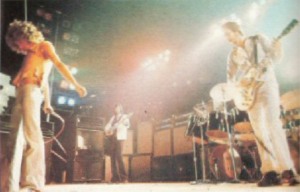
Ca. 1973, stage-right view of lighting tower and rear flown lighting.
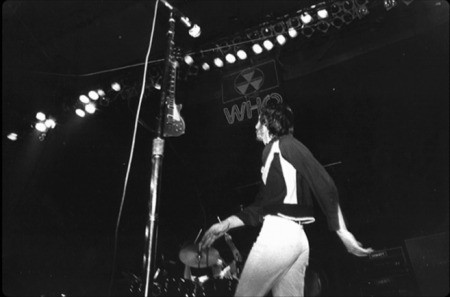
Ca. 1973, North American “Fallout Shelter” tour sign, built by McManus.

25 November 1973, Dallas, pre-show full view of lighting rig setup.
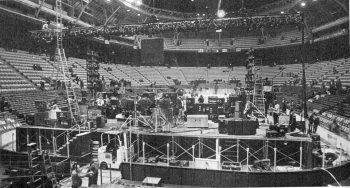
Click to view larger version. 28 Nov. 1973, St. Louis, view from back of arena of “Quadrophonic” PA and lighting rig/stage setup.
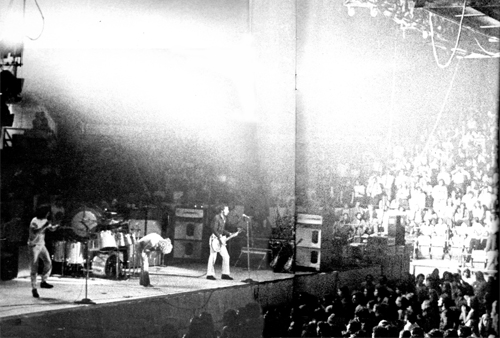
Ca. June 1974, Madison Square Garden.
1975–1976
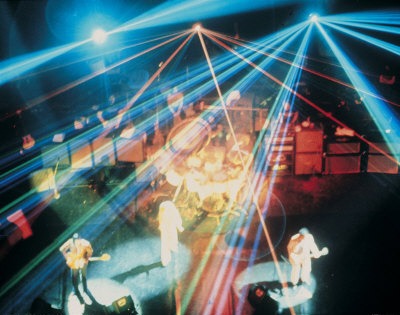
Roger Searle:
After that we started hiring lighting from Showco along with audio. Eventually the band entered in to the part ownership of a large Par Can rig (essential equipment in the late ’70s/early ’80s). This was controlled by an AVO QM500 desk which also had a “Who” plaque on it. The last time I saw this desk it was installed in a club in Romford, East London. It may now, however, be in the hands of a collector at a company called Litestructures in the UK.
Notes
1975 – First use of lasers:
The Who first used lasers on 18 Oct. 1975, at Granby Halls, Leicester.
Richard Barnes: “This tour was the first time they used their $36,000 lasers in the act and the first time lasers had been used in a rock show anywhere.”
The rock group The Who are generally recognised as pioneering the integration of the laser effects with music. John Wolff provided The Who with a few 90-second bursts of laser light from eleven lasers during their performances (Kallard 1979).
Excerpt from March 1976 article in Circus about the Fall 1975 U.S. tour kicking off in Houston:
Lighting for the concert was superb, with ultra-bright white spots situated at the rear of the stage and ignited at crucial moments (including the agonized screams in “Won’t Get Fooled Again”), flooding into the eyes of the audience. The group also experimented with laser beams (similar to the ones Led Zeppelin’s used on their last outing), which gave the effect of solid tubes radiating from the stage. The band was not allowed to use this laser setup in England, where the tour actually began in October, at the 8,000-seat New Bingley Hall in Stafford—so American audiences were the first to view its dramatic effect.
Excerpt from February 2010 Total Production International article featuring Wiggy on the development of lasers: Strung Out On Lasers (archived):
The Who introduced the effect on a large scale in a UK venue for the first time, at the unlikely Granby Halls, Leicester, on October 18 1975.
Roger Searle, who worked with The Who between 1967–86, and was then their lighting technician along with Tony Haslam, remembers the show featuring “just a single Spectra Physics 164 argon laser with no laser table — perched on a box at the back of the stage.
“Water was fed from a garden hose, power via a few yards of flex that we had borrowed... with John Wolff holding the diffraction grating in between finger and thumb.”
[…]
John ‘Wiggy’ Wolff, who today runs Syncrolite UK for former Showco president Jack Calmes (who sold Wolff his first laser) seems the least likely person to have started the laser revolution.
Wolff, who had already boasted the first real lightshow in rock’n’roll, had first seen lasers in use with Led Zeppelin at Earls Court in May 1975. However, seeing Steve Jander, Showco’s chief laser tech, nursing the laser to about 500–750mW output at Earls Court, two years on, Wiggy was immediately energised. The Who needed to get into lasers... on a large scale.
The popular story is that Showco’s Jack Calmes sold The Who their first laser — a US$36,000 purchase that Wolff would use spectacularly on ‘Won’t Get Fooled Again’. But one technician, Gerry Leitch, already part of the sound team that helped build The Who’s Ramport Studios in Battersea, before going on to become one of the UK’s leading laserists, remembers it somewhat differently — and that the laser was in part settlement of a debt owed to the band by the service company.
“The feeling I got at Earls Court was that here was a big show with one of my favourite bands and that was the best effect I had seen in a long time,” remembers Wolff. “But 1W or less was a toy. The only way to get a bright laser was with a big 4W green argon.”
Enter American light artist Rick Lefrak, who at the time was resident in London. “Rick and his girlfriend knocked on my door and said ‘I hear you are looking for a laser... we can hire you ours.’” In fact, they had been called in after Wolff had seen one of their promotional flyers advertising lasers and holograms.
His “girlfriend” was British Guianan born Alope — a hard-nosed business partner. They formed their own lighting company, Laughing Whitefish Productions, building the equipment in their Hampstead yard with local kids, with the advance money from landing a Lou Reed tour deal.
“Alope advertised that Laughing Whitefish could provide lasers and holography for the concert stage. And then Wiggy called and wanted a demo,” is how Lefrak puts it. “She told him we wanted £500 to give the demo and he reluctantly agreed — she had balls of steel.
“Wiggy gave us the money and we went laser hunting — and we also found Rank Strand diffraction gratings. I can’t remember the science lab that handed over a 4W argon laser to us hippies but God bless them. After a 30 minute lesson (like hook the water here, needs three-phase power there, and by the way the mirrors have to be perfectly aligned or you get nada), I headed to Shepperton where The Who and Wiggy were waiting.
“To cut a long story short, by sheer stubbornness and luck I got a beam — and lit a cigarette off it. We aimed it across the vast space and everyone gasped.”
[…] Lefrak: “Wiggy played with this awhile and we were on tour the next day in Leicester. Front page news the following day, and we were off and running. Led Zeppelin beat us but where they shot a single beam [in a transfer of Showco’s U.S. production] we hit with a heavy duty show.”
Wolff was a fearless visionary, says Lefrak. “His ambition and The Who’s money allowed us to add more lasers, including krypton, and to build machines to imitate our hand-held grating motions.”
[…]
...having sourced the 4W green argon and diffraction gratings with the aid of Lefrak, and crystal glass prisms from the scientific sector, the famous beam fans were created. The number of beams in the fan was determined by the number of lines on the diffraction grating and each beam in the fan was broken down into its component colour by the prisms and each colour directed separately to the scanners or other optics.
Read the full article at tpimagazine.com (archived). Also see part 2: Pioneering Beams (archived), on Wiggy’s hologram work.
Ludwigshafen, Germany, 6 Nov., 1975
Details of the lighting schemes, lasers and rear lamps, from 6 Nov. 1975, at Friedrich Eberthalle in Ludwigshafen, Germany. Photos courtesy of Affendaddy. See Affendaddy’s photo stream on Flickr.
For the 31 May, 1976, Charlton gig:
The £100,000 lighting system for the show:
- 30x Par 64 1,000-watt lamps
- 32x Leko 1,000-watt lamps
- Hydraulic “Genie” towers
- Electrosonic control desks
- Electrosonic Dimmer packs
- Strand Patt 765 follow spots
- 38 “00” three-section truss
- Vermet towers
- Ramport Lasers
Richard Barnes:
“The whole tour was a massive operation involving … 30 tons of equipment … Although loud, the sound was clear and sharp. The sound system specially built for the show by Tasco, and costing £7,000 just for that night alone, had never before been used in England. The long throw bass speakers ensured that even people at the back got high quality sound … At the climax of Listening to You all the £100,000 lights including the huge arc lights set up behind the group, facing out into the audience, were switched on, and the effect from this simple piece of theatrics produced one of rock’s greatest and most climactic moments…”
Photo gallery
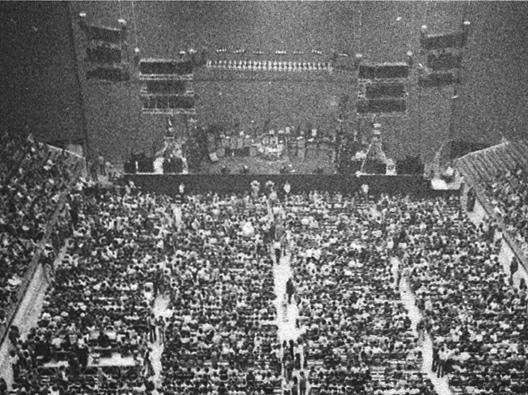
Ca. 1975, overhead view of arena stage setup, showing flown lighting rig.
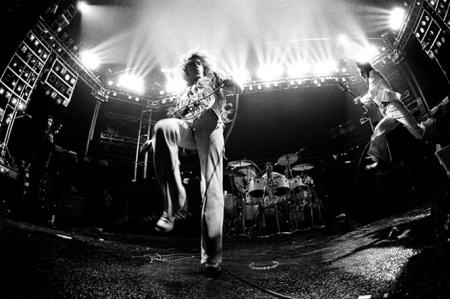
Ca. 1976, stage-front view of lighting rig.
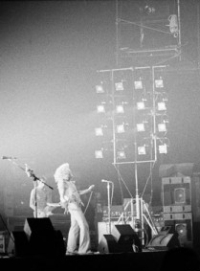
Ca. 1976, stage-left lighting.
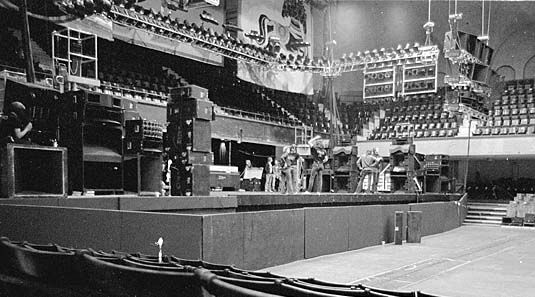
1976, stage setup at Winterland Auditorium, San Francisco. Courtesy thewho.org. © Dennis McCoy.
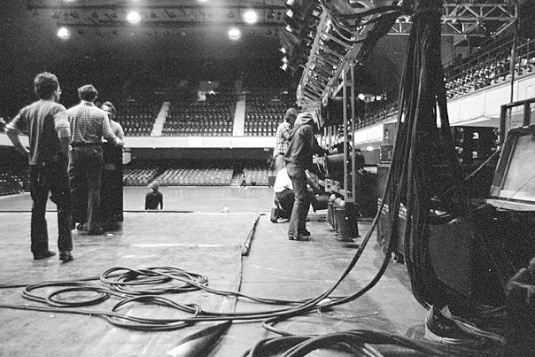
1976, lighting setup at Winterland Auditorium, San Francisco. Courtesy thewho.org. © Dennis McCoy.
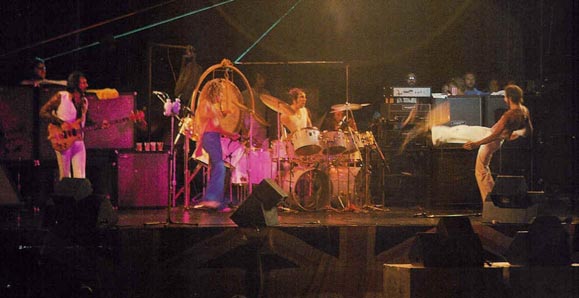
Ca. 1976. Courtesy whocollection.com.
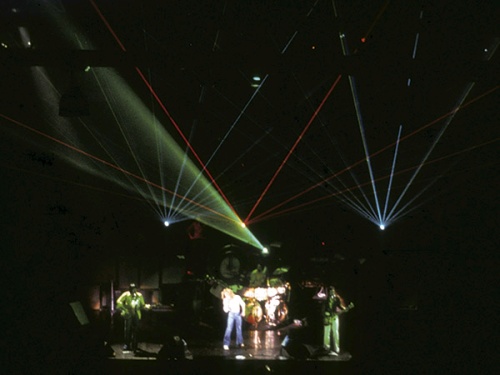
Ca. 1976, with laser projection visible from backstage.
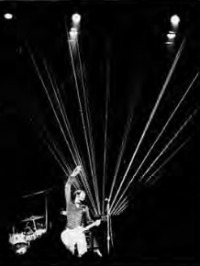
Ca. 1976, with laser projection visible from backstage.
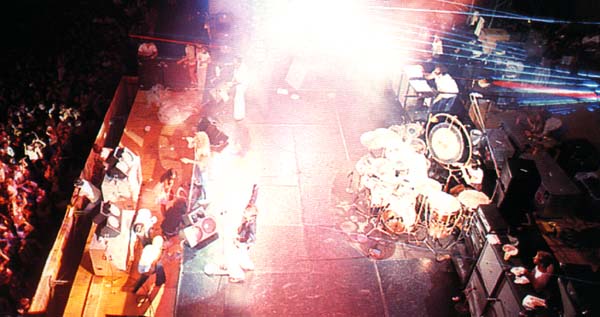
Ca. 1976, with laser projection visible from backstage.
After 1979
-
16 and 17 December 1982
The Who employed a special lighting display to illuminate Maple Leaf Gardens in Toronto for the Farewell Concert PPV.
See article excerpt: Lighting Dimensions: Lighting the Audience at THE WHO’s Final Concert
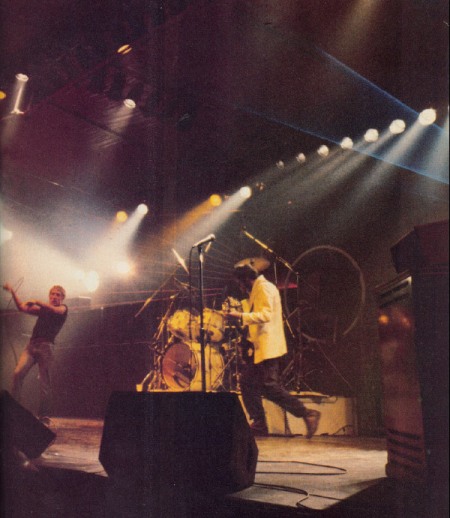
Ca. 1979, with laser projections visible from backstage.
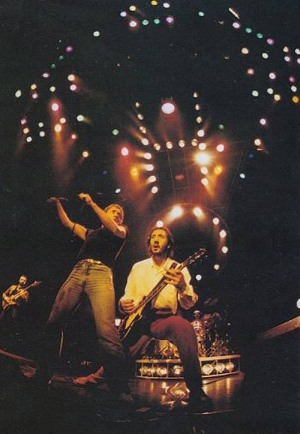
Ca. 1980, with “WHO” lighting truss.
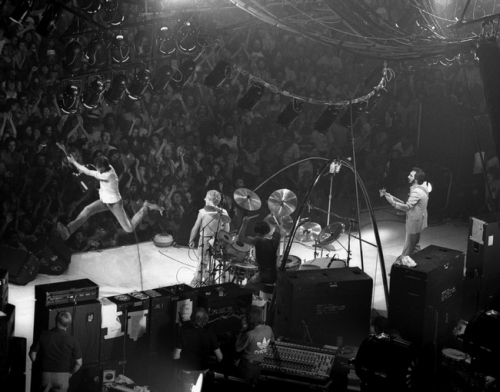
Ca. 1980, view from backstage, of lighting trusses, top, and film-style lamps, bottom right.
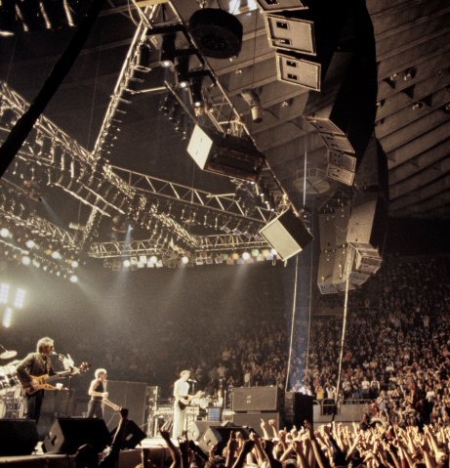
Ca. October 1982, with lighting truss visible.
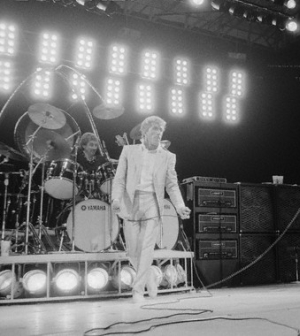
Ca. 1982, double rows of 16 2×8 aircraft lights for accent, used throughout the 1982 tour.
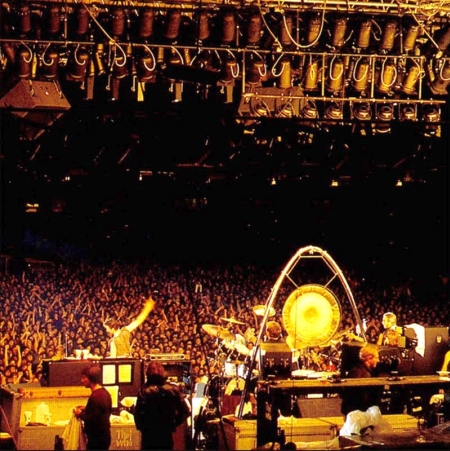
Ca. 1982, view from backstage.
Miscellaneous
-
2006–07
For the 2006/07 world tour, The Who used a combination of Barco, XL Video and George & Goldberg Design Associates for the video presentation.
See article excerpt: A Cornucopia of Visuals: Barco Lights The Who
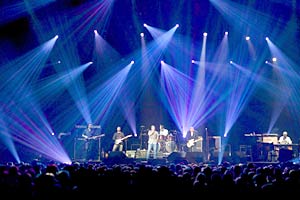
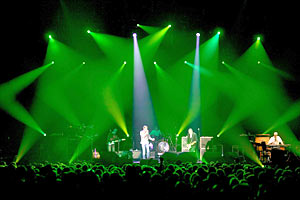
Resources
Acknowledgments
- Roger Searle
Manufacturers/Providers:
Articles
- Interview with Bill McManus on PLSN.com (offline)








